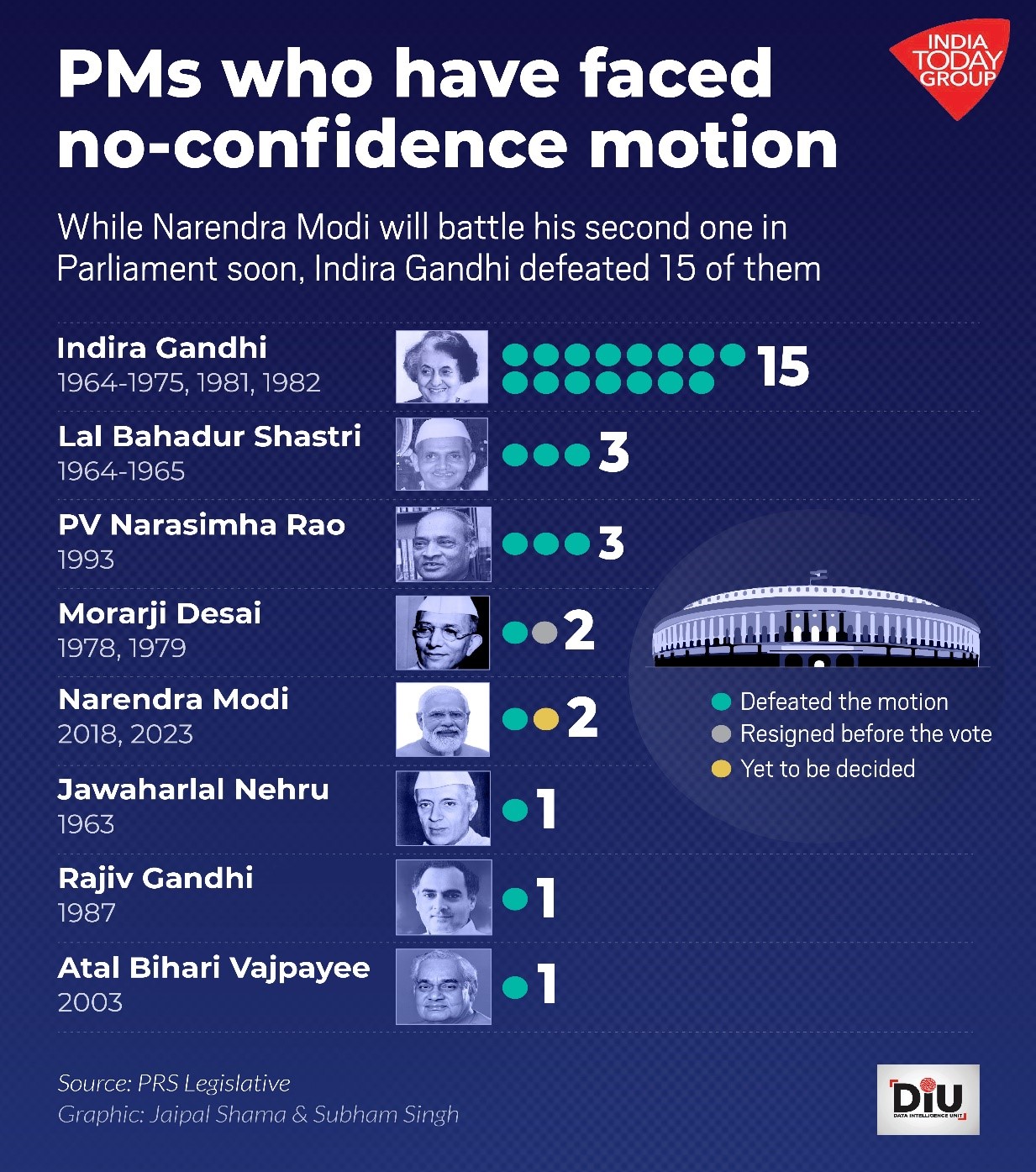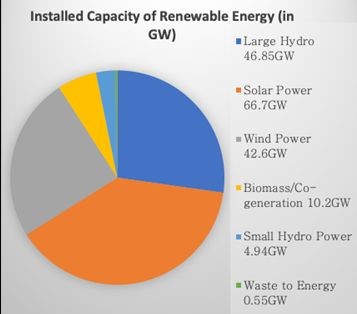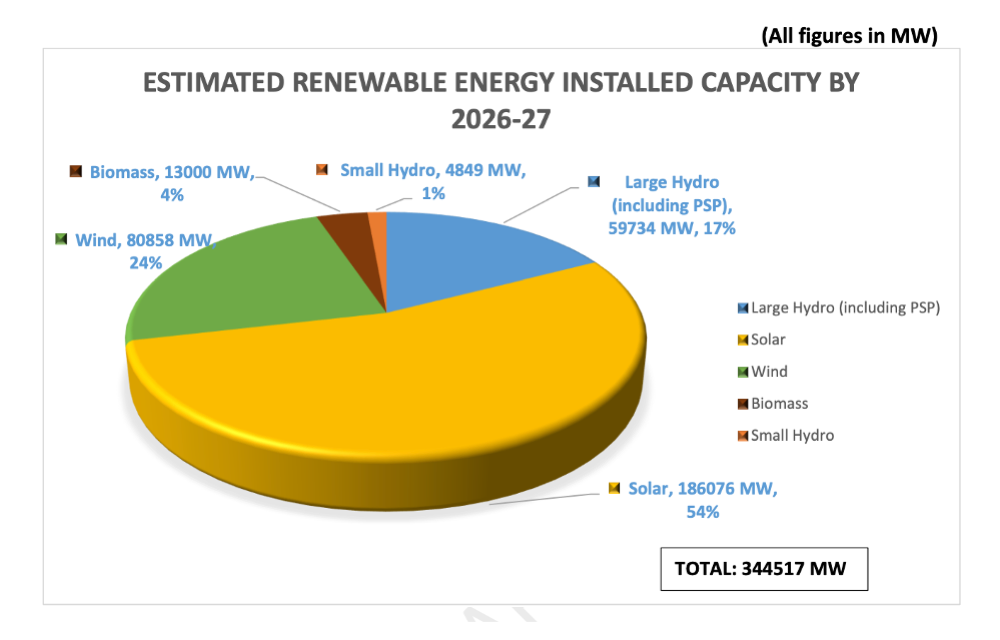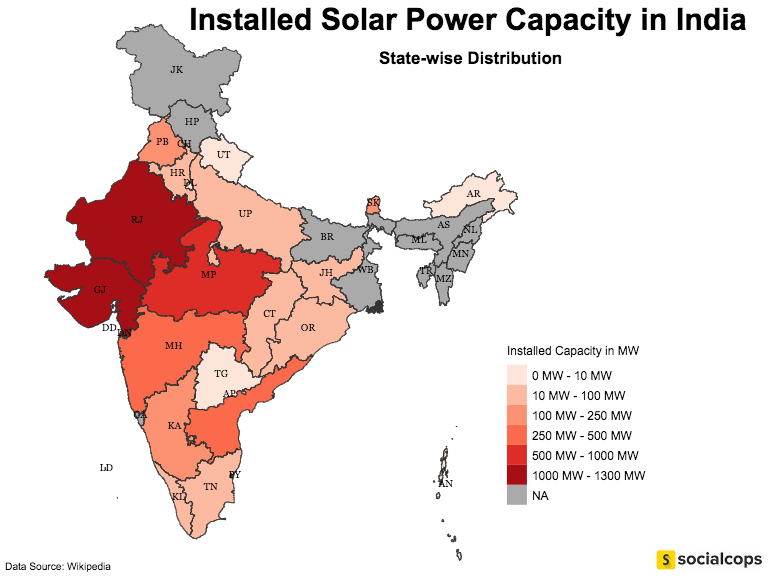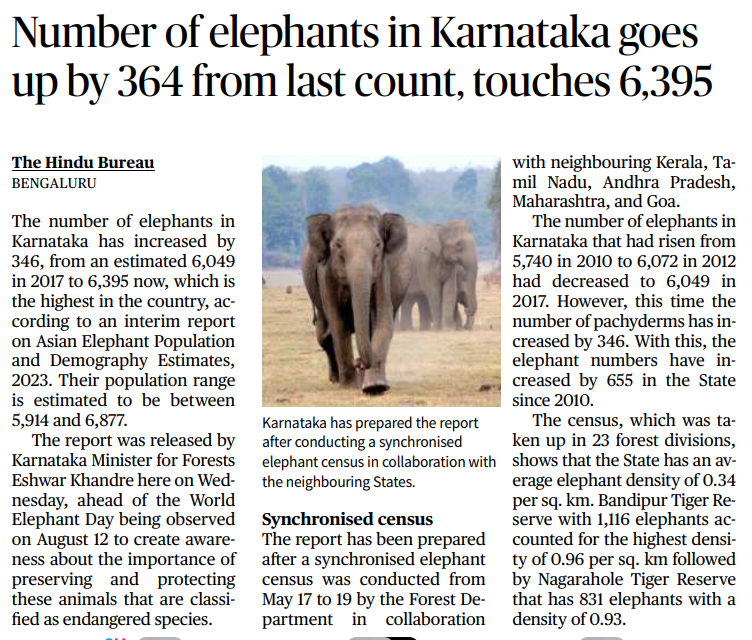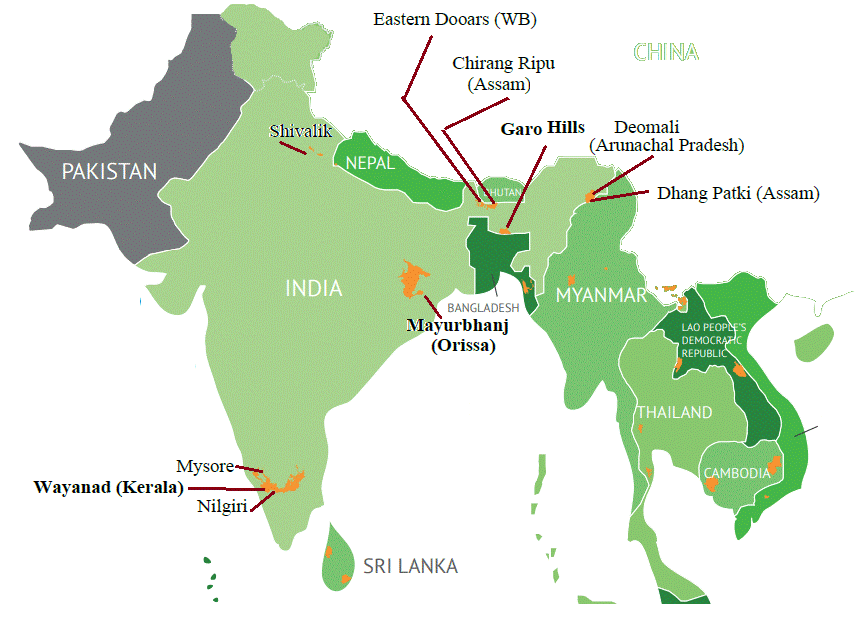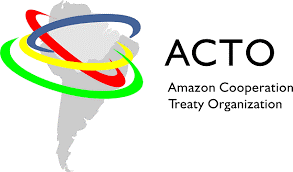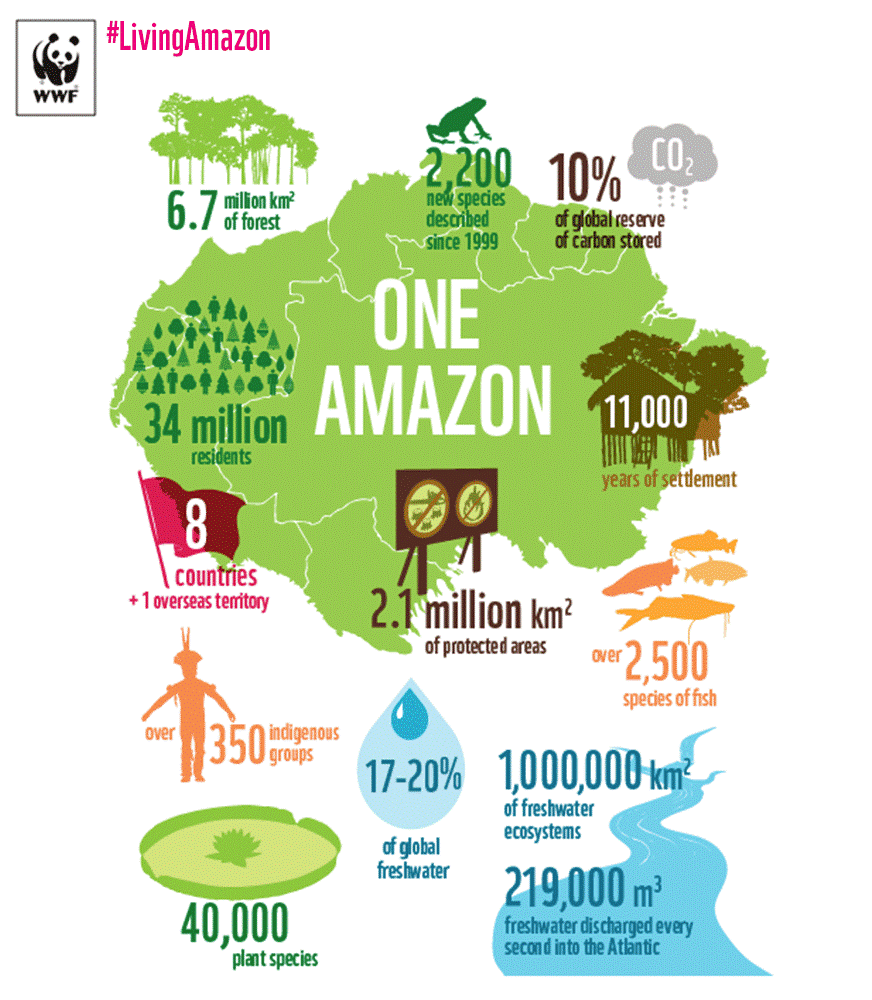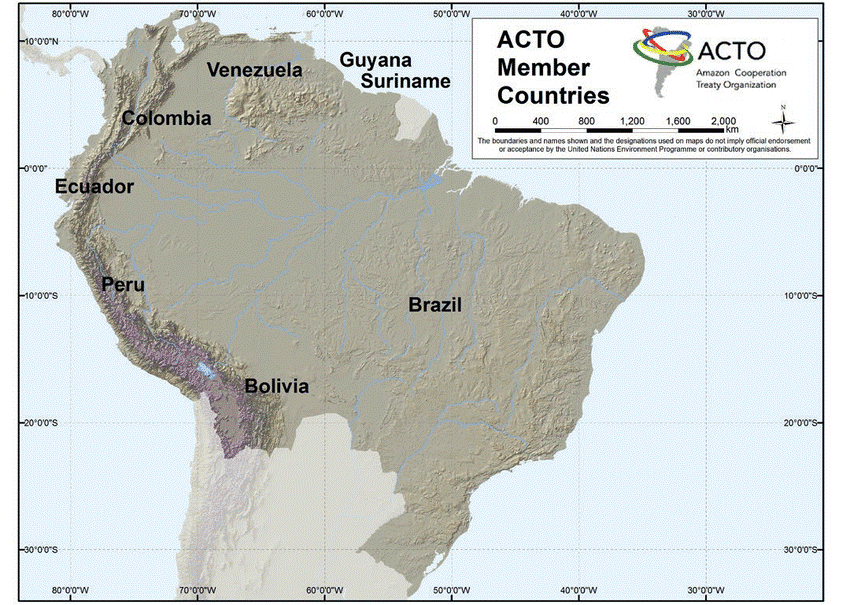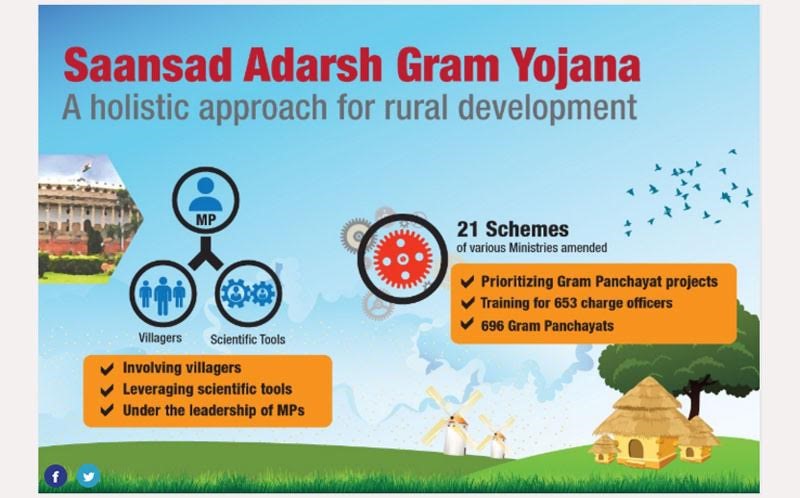Topics
- No Confidence Motion
- Solar Power Capacity of India
- MIKE Sites in India
- Amazon Treaty
- Saansad Adarsh Gram Yojana
- MAYA OS
No Confidence Motion
Definition and Procedure
- A no confidence motion is a parliamentary motion which is moved in the Lok Sabha against the entire council of ministers, stating that they are no longer deemed fit to hold positions of responsibility due to their inadequacy in some respect or their failure to carry out their obligations.
- The Constitution of India does not mention about either a confidence or a no confidence motion.
- Although, Article 75 does specify that the council of ministers shall be collectively responsible to the Lok Sabha.
- A motion of no confidence can be introduced only in the Lok Sabha under rule 198. The motion can be admitted when a minimum of 50 members support the motion in the house.
- Once the motion is moved, it is debated in the House for a maximum of 10 days. After the debate, the House votes on the motion. If a majority of the members vote against the government, the government falls.
- The speaker then, once satisfied that the motion is in order, will ask the house if the motion can be adopted.
A discussion on the motion takes place, where MPs who support the motion highlight the government’s shortcomings, and the treasury benches respond to the issues they raise. Finally, a vote takes place – in case the motion carries, the government is bound to vacate the office.
- A no confidence motion needs a majority vote to pass the house. If individuals or parties abstain from voting, those numbers will be removed from the overall strength of the house and then the majority will be taken into account.
SOLAR POWER CAPACITY IN INDIA
Installed Capacity and Renewable Goals
- In a recent parliamentary response, India’s current installed capacity stands at 70.1 GW.
- Meanwhile, the nation has set its sights on ambitious renewable energy goals, with plans to achieve 175 GW of renewable capacity by 2022 and a groundbreaking 500 GW by 2030.
- These targets position India as a global leader in renewable energy expansion.
Untapped Solar Potential
- The National Institute of Solar Energy has assessed India’s solar potential to be a staggering 748 GW.
- This estimation factors in a 3% coverage of wastelands using solar PV modules, highlighting the vast untapped potential for harnessing solar energy across the nation.
Solar PV Leadership and Installations
- India is making significant strides in solar energy production. The country ranks second in Asia and third globally for new solar PV capacity, having added 13 GW in 2021 alone.
- Impressively, India has overtaken Germany in total solar installations, boasting 60.4 GW compared to Germany’s 59.2 GW.
Top Solar Energy Producers – Rajasthan: 17,839.98 MW – Gujarat: 10,133.66 MW – Andhra Pradesh: 4,552.12 MW – Tamil Nadu: 6,892.81 MW – Karnataka: 9,050.59 MW |
Operational Initiatives
– Solar Park Scheme: Aiming to establish 40,000 MW capacity across a minimum of 50 solar parks.
– Grid-Connected Solar PV Power Projects: A scheme for 12,000 MW capacity, facilitated by Viability Gap Funding (VGF).
– Grid-Connected Solar Rooftop Power Plants: Promoting the installation of solar panels on rooftops.
– PM-KUSUM: This initiative supports decentralized solar power plants, standalone solar pumps, and the solarization of agriculture pumps.
– Production-Linked Incentives: A scheme under the “National Programme on High Efficiency Solar PV Modules” to encourage the production of efficient solar PV modules.
– Green Energy Corridor Scheme: Focused on the development of intra-state transmission systems to facilitate the efficient transport of green energy.
Financial Assistance for Solar Development
- Under the Solar Park Scheme, funds of up to Rs. 25 lakh per Solar Park are allocated for detailed project report (DPR) preparation, along with either Rs. 20 lakh per MW or 30% of the project cost for park infrastructure.
Conclusion
With its aggressive renewable energy targets, innovative operational initiatives, and strong financial support, India is poised to reshape its energy landscape and establish itself as a global leader in solar energy development.
MIKE SITES IN INDIA
Project Elephant: A Conservation Initiative for Wild Elephant
Introduction
- Project Elephant, launched in February 1992, stands as a notable federally funded endeavor aimed at providing assistance to states with free-roaming wild elephant populations.
- Its central objective revolves around safeguarding the continued existence of viable elephant populations within their natural habitats.
Implementation Across States
· The project’s influence spans across multiple states and Union Territories within India. These include Andhra Pradesh, Arunachal Pradesh, Assam, Chhattisgarh, Jharkhand, Karnataka, Kerala, Maharashtra, Meghalaya, Nagaland, Orissa, Tamil Nadu, Tripura, Uttarakhand, Uttar Pradesh, and West Bengal. These regions are active participants in the implementation of Project Elephant.
Assistance for Achieving Goals
· To accomplish the outlined goals of Project Elephant, states receive comprehensive support encompassing both financial aid and technical expertise.
· This assistance is instrumental in driving progress towards the project’s intended outcomes.
Extending Aid Beyond Core States
· Even states with smaller elephant populations benefit from the project’s initiatives.
· This aid involves conducting population surveys, imparting training to field staff, and addressing conflicts between humans and elephants, thereby fostering holistic elephant conservation.
Conservation Status and Global Context
· The Asian elephant, classified as “Endangered” on the IUCN Red List of Threatened Species, faces significant challenges to its survival.
· With an estimated global population ranging between 50,000 to 60,000 individuals, these elephants are at risk.
· Notably, India emerges as a custodian for over 60% of the global Asian elephant population.
· By organizing Project Elephant, India takes significant strides in preserving its diverse elephant heritage and contributes to the broader global endeavor of protecting these majestic creatures for generations to come.
Monitoring the Illegal Killing of Elephants (MIKE)
Introduction
- MIKE stands for Monitoring the Illegal Killing of Elephants. It is a programme mandated by the Convention on International Trade in Endangered Species of Wild Fauna and Flora (CITES) to measure the levels and trends of poaching of elephants in their range states.
- The programme aims to provide information and analysis for making decisions on elephant conservation and management, as well as to build the capacity of the range states for the long-term management of their elephant populations.
Image Source: Lotus Arise
ObjectivesThe main objectives of MIKE are: · To measure and record levels and trends of illegal killing of elephants at selected sites across Africa and Asia. · To determine changes in these trends over time and assess to what extent these changes are related to changes in the levels of illegal trade and other factors. · To establish an information base to support the making of decisions on appropriate management, protection and enforcement needs for elephant conservation. To build capacity in range states for elephant population monitoring, data collection, analysis and reporting. |
Sites
- There are currently 28 sites participating in the MIKE programme in Asia, distributed across 13 countries.
- India has the highest number of sites with 10, followed by two sites each in Cambodia, Indonesia, Lao PDR, Malaysia, Myanmar and Thailand, and one site each in Bangladesh, Bhutan, China, Nepal, Sri Lanka and Viet Nam.
The MIKE sites in India are:
- Chirang Ripu Dhang Patki in Assam
- Eastern Dooars in West Bengal
- Deomali in Arunachal Pradesh
- Garo Hills in Meghalaya
- Mayurbhanj in Odisha
- Mysore in Karnataka
- Nilgiri in Tamil Nadu
- Shivalik in Uttarakhand
- Wayanad in Kerala
Data Collection and Reporting
- Under the MIKE programme, data are collected from all sites on a monthly basis using a specified MIKE patrol form.
- The data include information on elephant carcasses encountered during patrols, such as location, cause of death, sex, age, tusk status, etc.
- The data are then submitted to the Sub Regional Support Office for South Asia Programme located in Delhi.
- The data are analysed and reported to CITES through periodic reports that assess the trends and patterns of elephant poaching across sites and regions.
- The reports also provide recommendations for improving elephant conservation and management.
Challenges and Opportunities
The MIKE programme faces several challenges in implementing its activities, such as lack of resources, capacity, coordination, security, accessibility, etc. Some of the challenges specific to India are:
- High human-elephant conflict due to habitat fragmentation and degradation.
- Inadequate law enforcement and prosecution of wildlife offenders.
- Low awareness and involvement of local communities and stakeholders.
- Lack of standardized methods and protocols for data collection and analysis.
However, there are also opportunities for enhancing the effectiveness and impact of the MIKE programme, such as:
- Strengthening collaboration and cooperation among range states, CITES, IUCN, NGOs and other partners.
- Leveraging existing initiatives and platforms for elephant conservation, such as Project Elephant, Elephant Reserves, etc.
- Improving data quality and reliability through training, supervision and validation.
- Increasing public awareness and education on the importance and value of elephants and their habitats.
Promoting best practices and lessons learned from successful models and experiences.
AMAZON TREATY
Context:
- In a recent gathering of leaders from Amazonian countries, including Bolivia, Brazil, Colombia, Ecuador, Guyana, Peru, Suriname, and Venezuela, the focus on protecting the invaluable rainforest remained elusive.
- The event, known as the Amazon Summit, was organized under the purview of the Amazon Cooperation Treaty Organization (ACTO).
The Belem Declaration: Recognizing Indigenous Wisdom
- Amidst the discussions at the Amazon Summit, a pivotal document emerged known as the Belem Declaration.
- This declaration underscored the importance of indigenous knowledge in the realm of biodiversity conservation.
- Notably, it called for a fundamental shift towards ensuring the meaningful participation of Indigenous Peoples in the formulation of public policies and decision-making processes.
Amazon Cooperation Treaty Organization (ACTO): Fostering Sustainable Development
- The Amazon Cooperation Treaty Organization (ACTO) stands as a crucial international entity committed to promoting sustainable development within the vast Amazon Basin.
Comprising member states such as Bolivia, Brazil, Colombia, Ecuador, Guyana, Peru, Suriname, and Venezuela, ACTO operates with the vision of harnessing the region’s potential while safeguarding its ecological balance.
Milestones and Evolution of ACTO
- The inception of the Amazon Cooperation Treaty (ACT) on July 3, 1978, marked a significant milestone in the journey towards Amazonian collaboration.
- Subsequently amended in 1998, this treaty laid the groundwork for the establishment of ACTO in 1995. The organization was conceived to enhance the effective implementation of the treaty’s provisions.
- To solidify its operational base, the Permanent Secretariat was established in Brasilia in 2002, serving as a hub for strategic coordination.
Brazil’s Hosting of the 2023 ACTO Summit
- Brazil’s proactive role within ACTO was evidenced when it announced its decision to host the 2023 Amazon Cooperation Treaty Organization Summit.
- Set to take place in August of the same year, this forthcoming summit holds the promise of renewed discussions and collaborative efforts to address the pressing challenges faced by the Amazon Basin and its member states.
SAANSAD ADARSH GRAM YOJANA
Introduction
- The programme aims to empower the villagers to make choices and provide them with opportunities to exercise those choices.
- The programme also seeks to create models of local development which can be replicated in other villages.
Objectives
- To develop model villages, called Adarsh Grams, through the implementation of existing schemes, and certain new initiatives to be designed for the local context, which may vary from village to village.
- To trigger processes which lead to holistic development of the identified Gram Panchayats.
- To substantially improve the standard of living and quality of life of all sections of the population through improved basic amenities, higher productivity, enhanced human development, better livelihood opportunities, reduced disparities, access to rights and entitlements, wider social mobilization, enriched social capital, etc.
- To generate models of local level development and effective local governance which can motivate and inspire neighbouring Gram Panchayats to learn and adapt.
Plan
- Under SAGY, each Member of Parliament (MP) has to identify one Gram Panchayat from the constituency that they represent, except their own village or their in-laws’ village, and develop it as a model village by 2019.
- Thereafter, they can take on two or three more villages and do the same by the time the next general elections come along in 2019, and thereafter, set themselves ten-year-long village or rural improvement projects.
The MPs are expected to facilitate the planning process, mobilize additional funds, monitor the scheme and ensure its timely completion.
The Gram Panchayats are expected to prepare Village Development Plans (VDPs) with the participation of the villagers and implement them with the support of various stakeholders.
Funding
- Funds from existing schemes, such as the Indira Awas Yojana, Pradhan Mantri Gram Sadak Yojana, Mahatma Gandhi National Rural Employment Guarantee Scheme, and Backward Regions Grant Fund, etc.
- The Member of Parliament Local Area Development Scheme (MPLADS).
- The Gram Panchayat’s own revenue.
- Central and State Finance Commission Grants.
- Corporate Social Responsibility funds.
Roles and responsibilities
- At the national level, two committees headed by the Minister of Rural Development and Secretary of Rural Development respectively monitor the process of identification and planning, review the implementation of the scheme, identify bottlenecks in the scheme, issue operational guidelines and indicate specific resource support which each Ministry can provide.
- At the state level, a committee headed by the Chief Secretary coordinates with Central Ministries/Departments for resource support to SAGY; reviews State specific guidelines; monitors progress; resolves issues arising out of convergence; facilitates training; documentation; etc.
- At the district level, a committee headed by the District Collector coordinates with line departments for technical support; monitors progress; facilitates training; documentation; etc.
- At the sub-district level (block or tehsil), a nodal officer is appointed to provide guidance to Gram Panchayats; coordinate with line departments for technical support; monitor progress; facilitate training; documentation; etc.
- At the village level (Gram Panchayat), a team consisting of MP/representative of MP; Sarpanch/Pramukh/Zila Parishad member/Block Samiti member;
- three women members from Self Help Groups (SHGs);
- two members from weaker sections such as SC/ST/Minorities/PwDs; one member from Civil Society Organisation (CSO)/NGO working in that area;
- one member from youth organisation such as NSS/NCC/NYK etc.;
- one member from local school/college/university etc.;
- one member from local business/trade association etc.;
- one member from local health centre/hospital etc.;
- one member from local bank/post office etc.; is constituted to facilitate participatory planning process; mobilise community contribution;
- oversee implementation of VDPs; ensure transparency and accountability; etc.
Conclusion
SAGY is a unique and innovative programme that aims to transform the rural landscape of India by harnessing the potential of the villagers and the MPs. The programme is based on the principles of demand-driven, inspired by society and based on people’s participation.
The programme has shown positive results in terms of improving the physical and institutional infrastructure, social and economic development and quality of life in the selected villages. The programme also has the potential to inspire and motivate other villages to emulate the best practices and achieve holistic development.
MAYA OS
Context
- In a significant stride towards bolstering its cybersecurity measures, the Defence Ministry is introducing a homegrown operating system called Maya OS.
- This move is aimed at replacing Microsoft’s Windows OS on all computers within the ministry, with the goal of providing enhanced protection against cyberattacks.
Understanding Maya OS: Origin, Features, and Purpose
Origin and Purpose of Maya OS
- Maya OS is an operating system developed by the Union Ministry of Defence, marking a notable achievement in India’s technological landscape.
The Significance of the Name
- Drawing inspiration from the ancient Indian concept of illusion, Maya OS is aptly named to symbolize the deceptive nature of reality.
Open-Source Framework: Leveraging Ubuntu
- Maya OS is built upon the Ubuntu platform, adhering to open-source principles by utilizing publicly available software.
- This approach fosters transparency, community collaboration, and customization options.
Introducing the Chakravyuh Feature
- Maya OS introduces a distinctive feature known as Chakravyuh, functioning as an end-point anti-malware and antivirus software.
- This innovative feature acts as a protective shield against unauthorized access attempts, safeguarding sensitive data and users from online threats.
User Interface, Features, and Compatibility
User-Friendly Interface
- Maya OS offers a user interface designed for familiarity, mirroring the look and feel of Windows.
- This design choice ensures a comfortable and seamless user experience.
Application Compatibility
- Ensuring a smooth transition for users, Maya OS supports popular software applications such as Microsoft Office, Adobe Photoshop, and AutoCAD, ensuring compatibility with widely-used tools.
Enhanced Security Measures
- Maya OS prioritizes security through various measures, including cloud storage, encryption, digital signatures, and biometric authentication, enhancing the overall safety of the operating system.
The Development Journey of Maya OS;
Initiation Prompted by Emerging Threats
- In response to the escalating cyberattacks on India’s critical infrastructure and defence systems, the development of Maya OS was initiated in 2021 to address the growing cybersecurity challenges.
Collaborative Endeavors
- The development of Maya OS was a collaborative effort involving experts from prominent government agencies like DRDO, C-DAC, NIC, along with contributions from Indian software companies and academic institutions.
- This collective expertise played a crucial role in the OS’s development.
Rapid Progress
The collaborative teams demonstrated remarkable dedication and expertise, resulting in the successful creation of Maya OS within a remarkably short span of 6 months. This achievement highlights the efficiency and commitment of the teams involved in its development.


